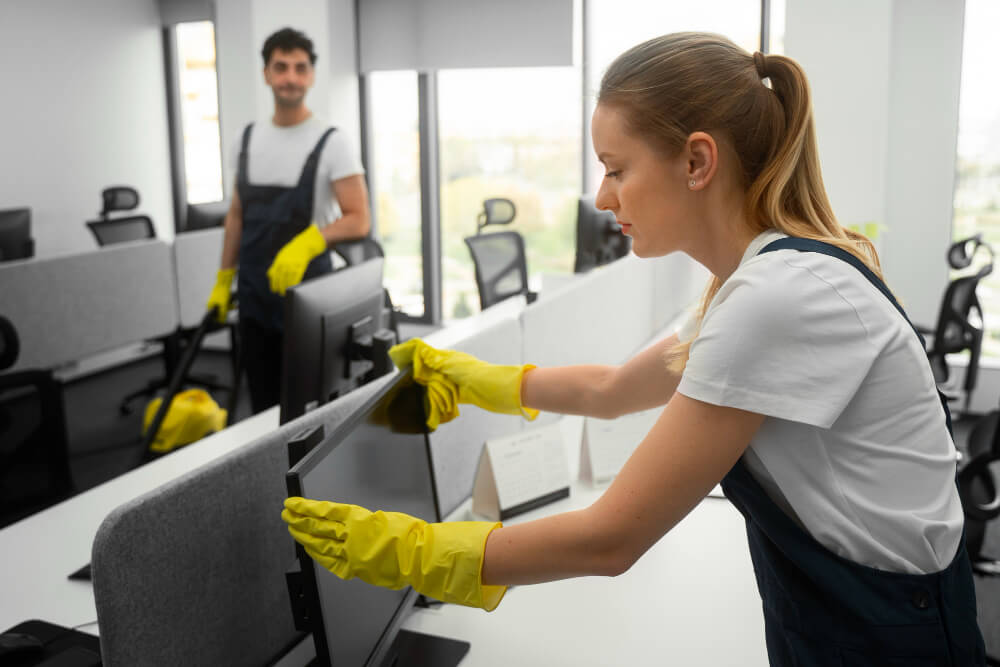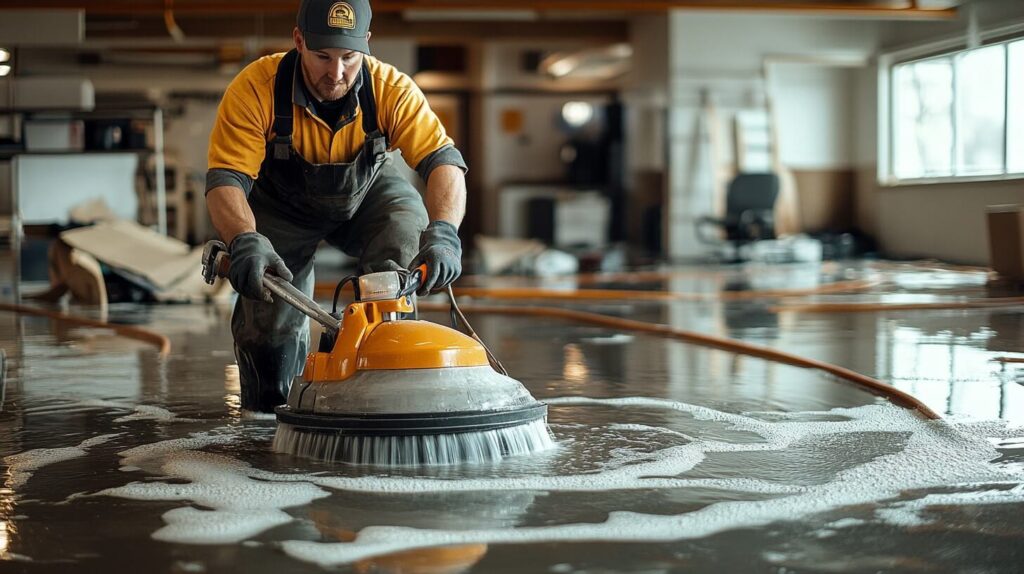As businesses in Auckland become more conscious of their environmental impact, many are exploring eco-friendly commercial cleaning solutions.
Transitioning to sustainable practices can seem daunting, but the benefits to your business, employees, and the environment make it a worthwhile investment.
This comprehensive guide will address common questions and concerns, provide practical tips, and share relatable examples to help you implement green cleaning practices in your business.

Common Questions and Concerns
Why Should My Business Consider Eco-Friendly Cleaning Solutions?
Many business owners wonder if eco-friendly cleaning solutions are worth the investment.
Here are some key benefits:
- Healthier Work Environment: Green cleaning products reduce exposure to harmful chemicals, promoting better health for employees and customers. Traditional cleaning products can contain volatile organic compounds (VOCs) that contribute to respiratory issues, headaches, and other health problems. By choosing eco-friendly alternatives, you can improve indoor air quality and create a safer workplace.
- Environmental Impact: Sustainable practices help reduce pollution and conserve resources, contributing to a healthier planet. Traditional cleaning products often contain harsh chemicals that can harm aquatic life and contribute to soil and water pollution. Green cleaning products are biodegradable and less toxic, making them a better choice for the environment.
- Brand Image: Demonstrating a commitment to sustainability can enhance your brand’s reputation and attract eco-conscious clients. Consumers are increasingly looking for businesses that align with their values. By adopting green cleaning practices, you can differentiate your business and appeal to a growing market of environmentally conscious customers.
Are Eco-Friendly Cleaning Products Effective?
A common concern is whether green cleaning products can match the effectiveness of traditional cleaners.
The good news is that many eco-friendly products are just as effective, if not more so, than their conventional counterparts.
Look for products with certifications from reputable organizations to ensure they meet high standards for performance and safety.
Certifications to look for include Green Seal, EcoLogo, and the EPA Safer Choice label.
How Can My Business Implement Sustainable Cleaning Practices?
Switching to eco-friendly cleaning solutions doesn’t have to be overwhelming.
Here are some practical steps:
- Choose Certified Products: Look for labels like Green Seal, EcoLogo, or EPA Safer Choice to ensure the products you select meet high environmental and performance standards.
- Train Your Staff: Educate your cleaning team on the importance of sustainable practices and how to use green products effectively. Proper training ensures that your staff understands how to use eco-friendly products correctly and efficiently.
- Reduce Waste: Implement recycling programs and use reusable cleaning tools, such as microfiber cloths. Reducing waste is an essential aspect of sustainable cleaning practices.
- Optimize Cleaning Schedules: Clean during off-peak hours to save energy and reduce disruptions. Scheduling cleaning tasks during times when the building is less occupied can also improve safety and efficiency.
Relatable Examples and Personal Stories
A Local Café’s Green Transformation
When a popular Auckland café decided to go green, the owners started by swapping out their conventional cleaning products for eco-friendly alternatives.
They noticed an immediate improvement in air quality and a decrease in respiratory issues among staff.
Customers appreciated the café’s commitment to sustainability, leading to increased loyalty and word-of-mouth referrals.
This transformation not only improved the health and well-being of the staff but also boosted the café’s reputation as an eco-conscious business.
Corporate Office’s Sustainable Journey
A large corporate office in Auckland implemented a comprehensive green cleaning program.
They invested in biodegradable cleaners, trained their janitorial staff, and introduced recycling bins.
Over time, they saw a reduction in waste and energy consumption, alongside positive feedback from employees who felt more comfortable in their workspace.
The company’s commitment to sustainability also attracted new clients who valued environmentally responsible practices.
Eco-Friendly Cleaning in a School Setting
An Auckland primary school decided to switch to eco-friendly cleaning products to create a healthier environment for students and staff.
The school replaced traditional cleaning supplies with green alternatives, such as non-toxic disinfectants and biodegradable detergents.
Teachers and parents noticed a decrease in allergy and asthma symptoms among students, and the school’s commitment to sustainability became a point of pride for the community.
Practical Tips for Sustainable Cleaning
Opt for Green Cleaning Products
- Look for Certifications: Products with certifications like Green Seal, EcoLogo, or EPA Safer Choice have been vetted for their environmental impact and effectiveness. These certifications ensure that the products meet rigorous standards for safety and performance.
- Check Ingredients: Avoid products with harsh chemicals like ammonia, bleach, and phosphates. Instead, choose products with natural, plant-based ingredients that are less harmful to health and the environment.
- Use Multi-Purpose Cleaners: Reduce the number of different cleaning products you use by selecting multi-purpose cleaners that can handle various tasks. This approach simplifies your cleaning routine and minimizes waste.
Train Your Cleaning Staff
- Educate on Proper Use: Ensure your team knows how to use eco-friendly products correctly to maximize their effectiveness. Proper training can prevent overuse and waste of cleaning products.
- Promote Best Practices: Encourage practices like using the right amount of product, proper ventilation during cleaning, and regular maintenance of cleaning equipment. Best practices can enhance the efficiency and effectiveness of your cleaning program.
- Ongoing Training: Regularly update your staff on new products and techniques to keep them informed about the latest advancements in green cleaning.
Implement Recycling and Waste Reduction Programs
- Recycle: Set up recycling stations for paper, plastic, and other materials. Clearly label bins to encourage proper sorting and make recycling easy for employees and visitors.
- Reduce Single-Use Items: Use reusable cleaning cloths and mops instead of disposables. Reusable items are more durable and generate less waste.
- Compost Organic Waste: If your business generates organic waste, consider setting up a composting program. Composting can reduce the amount of waste sent to landfills and provide valuable nutrients for landscaping.
Schedule Cleaning Wisely
- Energy Efficiency: Clean during off-peak hours to save on energy costs. Off-peak cleaning can also reduce the strain on HVAC systems and improve overall energy efficiency.
- Minimize Disruptions: Schedule cleaning activities at times that are least disruptive to your business operations. Cleaning during off-hours can create a more pleasant environment for employees and customers.
- Coordinate with Building Maintenance: Work with your building’s maintenance team to schedule cleaning tasks in conjunction with other maintenance activities. Coordinated efforts can improve efficiency and reduce resource consumption.
Additional Resources
To further assist you in your journey towards sustainable cleaning, here are some additional resources:
- Green Cleaning Product Guides: Websites like Green Seal and EcoLogo offer product guides and recommendations.
- Sustainable Business Practices: The New Zealand Sustainable Business Network provides resources and support for businesses looking to adopt sustainable practices.
- Environmental Certifications: Learn more about environmental certifications and how they can benefit your business from the EPA Safer Choice program.

Real-Life Benefits of Eco-Friendly Cleaning
Improved Employee Health and Productivity
Studies have shown that improved indoor air quality can lead to better health outcomes for employees.
Reduced exposure to harmful chemicals can decrease the incidence of respiratory issues, allergies, and other health problems.
Healthier employees are more productive and less likely to take sick leave, benefiting both the individuals and the business.
Cost Savings Over Time
While eco-friendly cleaning products may have a higher upfront cost, they can lead to cost savings over time.
Many green products are concentrated, requiring less product per use. Additionally, durable, reusable cleaning tools reduce the need for frequent replacements.
Energy savings from optimized cleaning schedules and reduced waste disposal costs also contribute to long-term savings.
Positive Environmental Impact
By choosing eco-friendly cleaning solutions, your business can significantly reduce its environmental footprint.
Reduced chemical runoff, lower energy consumption, and decreased waste all contribute to a healthier planet.
Your efforts in sustainability can inspire other businesses and individuals to follow suit, amplifying the positive impact.
Tips for Choosing Eco-Friendly Cleaning Services
If your business outsources its cleaning needs, it’s important to choose a cleaning service that aligns with your sustainability goals.
Here are some tips for selecting an eco-friendly cleaning service:
- Ask About Products: Inquire about the cleaning products they use and whether they have certifications like Green Seal or EcoLogo.
- Review Their Practices: Ask about their waste reduction strategies, recycling programs, and energy-efficient practices.
- Check References: Look for reviews or ask for references from other businesses that have used their services.
- Evaluate Their Training: Ensure that their staff is trained in using eco-friendly products and practices.
Overcoming Challenges in Implementing Eco-Friendly Cleaning
Transitioning to eco-friendly cleaning practices can come with challenges, but they are manageable with the right approach.
Here are some common challenges and how to overcome them:
Initial Costs
Eco-friendly products and equipment may have a higher upfront cost. To manage this, consider:
- Phased Implementation: Gradually replace traditional products with green alternatives to spread out costs.
- Bulk Purchasing: Buy in bulk to take advantage of discounts and reduce per-unit costs.
- Calculate Long-Term Savings: Highlight the long-term savings from reduced health issues, lower waste disposal costs, and energy efficiency to justify the initial investment.
Staff Resistance
Employees may be resistant to change, especially if they are accustomed to traditional cleaning products.
To address this:
- Provide Education: Explain the health and environmental benefits of eco-friendly products.
- Offer Training: Conduct hands-on training sessions to familiarize staff with new products and practices.
- Involve Employees: Engage employees in the decision-making process to gain their buy-in and support.
Finding Reliable Products
Not all green products are created equal. Some may not meet your performance standards.
To ensure you choose the best products:
- Research: Look for products with reputable certifications and positive reviews.
- Test Products: Conduct trials with different products to determine which ones work best for your needs.
- Seek Recommendations: Ask for recommendations from other businesses or industry experts.
Conclusion
Eco-friendly commercial cleaning solutions offer numerous benefits for businesses in Auckland.
By addressing common questions and concerns, providing practical tips, and sharing relatable examples, this guide aims to make the transition to sustainable cleaning practices more accessible and achievable.
Remember, every small step towards sustainability counts, and your efforts can contribute to a healthier environment and a better future for all.